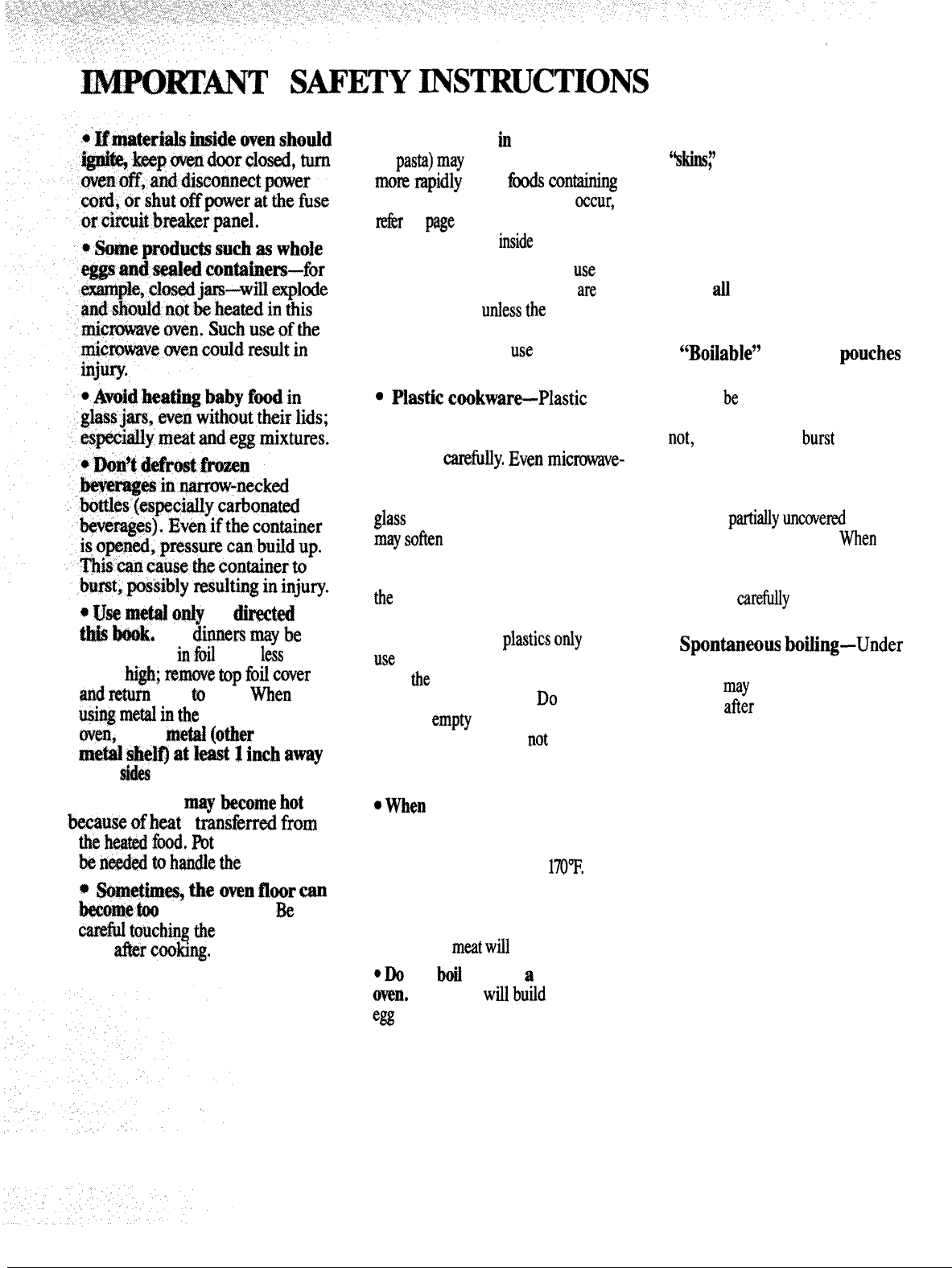
WO~NT
S~E~
mSmUCTIONS
(Continual)
*
Use
meti
o~y as
dimted
in
M
Wk.
TV
dinners
may
he
microwaved
in
foil
trays
10ss
than
3/4’’ h@;
remov~
top
foti
cover
and
return
tray
to
box.
men
wing
meti
in
the
microwave
oven,
keep
meti
(other
than
rn-
shelfi
at
-1
inch
away
from
sides
of oven.
●
Cookware
may
become
hot
-useofhwt
transfemdtiom
the
h~ted
tid,
Pot
holders may
be
n*d
to
htie
the
cookware.
*
*m&tkes,
the
oven
floor
w
tim$too
hot to touch.
Be
careM
touching
the
floor during
and
~er
cooking,
●
Foods cooked
in
liquids
(such
as
pasta)
may
tend to boil over
mom
rnpidly
than
m
co-
less moisture. Should this
occur,
&r
to
p~e
25 for instructions on
how to clean the
inside
of the oven.
* Thermometer—Do not
use
a thermometer in food you
are
microwaving
urdess
the
thermometer is designed or
recommended for
use
in the
microwave oven.
@
Plwtic
cookwar*Plastic
cookware designed for microwave
cooking is very useful, but should
be used
carefi~y.
Even
microwave-
safe plastic may not be as tolerant
of overcooking conditions as are
glass
or ceramic materials and
may
safien
or char if subjected to
short periods of overcooking. In
longer exposures to overcooking,
the
food and cookware could
ignite. For these reasons: 1) Use
microwave-safe
plastics
ody
and
use
them in strict compliance
with
the
cookware manufacturer’s
recommendations. 2)
Do
not
subject
emp~
cookware to
microwaving. 3) Do
not
permit
children to use plastic cookware
without complete supervision.
*
When
cooking pork,
follow
the directions exactly and always
cook the meat to an internal
temperature of at least
170W,
This assures that, in the remote
possibility that trichina may be
present in the meat, it will be
killed and
meat
wfil
be safe to eat.
*
Do
not
bofl
eggs in
a
microwave
own.
Pressure
wdl
budd
up inside
egg
yolk and will cause it to
burst, possibly resulting in injury.
●
Foods with
unbroken outer
‘%kins~’
such as potatoes, sausages,
tomatoes, apples, chicken livers
and other giblets, and egg yolks,
(see previous caution) should be
pierced to allow steam to escape
during cooking.
●
Not
W
plastic wrap is suitable
for use in microwave ovens,
Check the package for proper use.
.
$~Boilab]e”
cooking
Wuchm
and tightly closed plastic bags
should
be
slit, pierced or vented
as directed by package. If they are
not,
plastic could
burst
during
or immediately after cooking,
possibly resulting in injury. Also,
plastic storage containers should be
at least part~y
uncoveti
because
they form a tight seal.
men
cooking with containers tightly
covered with plastic wrap, remove
covering
carefilly
and direct steam
away from hands and face.
.
spon~neous
boiKng-Under
certain special circumstances,
liquids
may
start to boil during or
shortly
after
removal from the
microwave oven. To prevent burns
from splashing liquid, stir the
liquid briefly before removing the
container from the microwave oven.
4


















